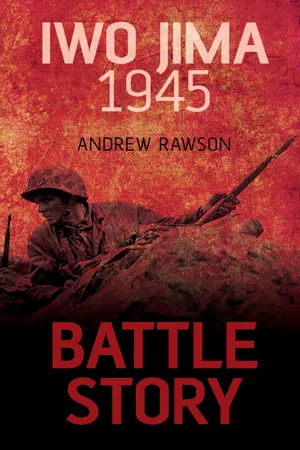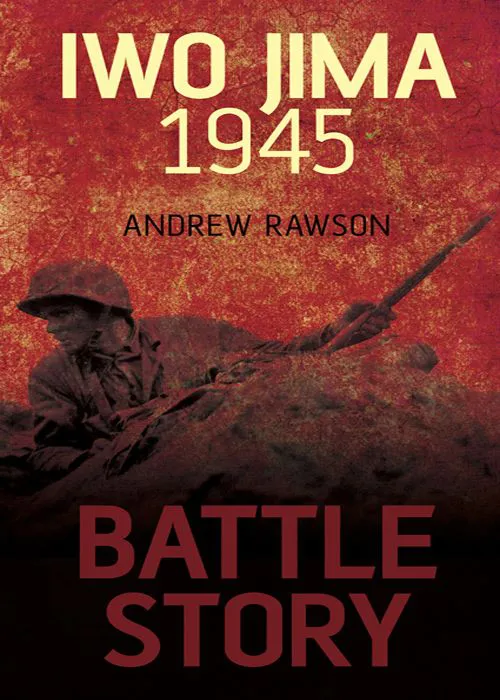![]()
Cover
![]()
CONTENTS
Introduction
Timelines
Historical Background
Strategic Planning
Operational Planning
Planning Operation Detachment
The Armies
Commanders
US Marines
The Japanese
The Days Before the Assault
The Invasion Plans
Gathering Intelligence
Logistics and Administration
Training and Rehearsals
Sailing to Iwo Jima
The Preliminary Bombardment
Securing the Beachhead (D-Day to D+7)
D-Day, 19 February 1945
Cutting off Hot Rocks (D+1 to D+4)
4th Division Advances toward Airfield 1
The Battle for Hot Rocks (D+1 to D+4)
The Battles for Airfield 1 and the Quarry (D+1 to D+2)
The Advance towards Airfield 2 and Minami (D+3 and D+4)
Clearing Airfield 2 and the Advance to Charlie-Dog Ridge (D+5 to D+7)
Securing the Island (D+8 to D+19)
5th Division’s Advance to Hill 362A and Nishi Ridge (D+8 to D+14)
3rd Division’s Advance to Motoyama and Airfield 3 (D+8 and D+14)
4th Division in the Meat Grinder (D+8 and D+14)
5th Division’s Advance to Kitano Ravine (D+15 to D+19)
3rd Division’s Advance to the East Coast (D+15 to D+19)
4th Division Takes Minami and Higashi (D+15 to D+19)
The Final Phase (D+20 to D+35)
RCT 21 Advances to Kitano Point (D+25)
4th Division Clears Tachiiwa Point (D+20 to D+25)
To Kitano Point (D+20 to D+25)
The Battle for Kitano Gorge (D+20 to D+35)
The Final Days
The Legacy
Leaving Iwo Jima Behind
The Cost
The Battle for Okinawa
The Atomic Bomb
Orders of Battle
Further Reading
![]()
INTRODUCTION
On 7 December 1941, Japanese planes attacked Pearl Harbor in the Hawaiian Islands and bases in the Philippines, bringing the United States of America into the Second World War. The first naval battle took place in May 1942, when Allied ships prevented a Japanese fleet taking control of the seas north of Australia. In the four-day Battle of the Coral Sea the Allied forces suffered heavy losses, but they achieved their objective of thwarting the Japanese invasion plans.
Admiral Isoroku Yamamoto wanted to lure the US Navy into battle to get the upper hand in the Pacific. It was clear that a new style of naval warfare was developing, one in which the aircraft carrier played the leading role instead of the battleship. Technological advances in aerial warfare meant that planes could track down and destroy enemy ships long before the fleets saw each other.
Allied code breakers had broken the Japanese naval code by late May 1942 and when they discovered that Yamamoto intended to capture Midway Island, halfway between Japan and Hawaii, US carriers sailed towards it looking to outmanoeuvre their adversaries. Contact was made on 4 June and in the battle that followed four Japanese carriers were destroyed or damaged, resulting in a decisive US Navy victory. Midway would later be seen as a turning point in the Pacific War.
While the Japanese had been stopped in the Eastern Pacific, they were still on the offensive in the Western Pacific, advancing in the Solomon Islands and in New Guinea. But they had been stopped by September 1942 and the Allies counterattacked later in the year. General William Slim’s British and Indian XIVth Army was also holding its own in Burma.
US Marines had landed on Guadalcanal in the Solomon Islands in August 1942 but it took a six-month-long deadly battle of attrition to clear it. The stubborn Japanese defence was a taste of what was to come in the Allied island hopping campaign, as they moved slowly across the Pacific towards the Japanese homeland. Islands had to be invaded, secured and then turned into air and naval bases ready for the next stage of the campaign. While many islands were captured, others – such as Truk, Rabaul and Formosa – were bypassed and bombed into submission.
The invasion of the tiny Tarawa Atoll in the Gilbert Islands in November 1943 was a bloody experience for the Marines but they learnt many lessons about amphibious landings that were applied at Iwo Jima fifteen months later. At the same time, President Franklin D. Roosevelt, Prime Minister Winston Churchill and Generalissimo Chiang Kai-shek met in Cairo to agree a strategy to defeat Japan. While America was gearing up its industrial capacity for war, equipping not only its own armies but that of China, the Japanese Armed Forces were suffering because of the country’s lack of industry and resources.
While the United States Navy and Marines were advancing slowly across the Pacific, the Imperial Japanese Army struck back in the India-Burma-China Theatre. While Operation U-Go, an offensive into India in March, was stopped at Kohima and Imphal, Operation Ichi-Go, a couple of months later, struck deep into China to attack Allied airfields.
The invasion of Saipan in the Marianas Islands on 15 June 1944 was the next step in the Eastern Pacific and over 125,000 Army troops and Marines would eventually be involved in the battle for the island. Virtually every available Japanese ship was ordered to the area but the air attacks on Fifth Fleet, starting on 19 June, were a complete disaster. The Japanese Navy lost three aircraft carriers and 450 planes in the two-day battle while the US Navy only lost 130 planes; most of them crashed while trying to land on their carriers. The Japanese carrier fleet never recovered from what became known as the Great Marianas Turkey Shoot.
General Douglas MacArthur then began his invasion of the Philippines Islands in the southwest Pacific; over 600 Japanese ground-based planes were destroyed trying to stop it. The Japanese Navy tried next and the four-day Battle of Leyte Gulf in October 1944 became arguably the largest naval battle in history; it was also the first time that Japanese pilots carried out kamikaze attacks, crashing their planes into carriers and battleships in a desperate attempt to sink them. Instead three Japanese carriers were sunk and a fourth was disabled on 24 October; another was sunk the following day, ending the Japanese Navy’s ability to carry out attacks. It left Sixth Army free to expand its beachhead on Leyte and by the end of December the island was secure.
The rest of the Philippines operations followed, with an amphibious assault of Mindoro in December and Luzon in January; by 3 February US troops were in the capital, Manila. Luzon would become the largest campaign of the Pacific War while the invasion of Mindanao in April would complete the conquest of the Philippines.
The Allied offensives in Burma continued throughout 1944 and American troops linked up with Chinese troops in the north in January. To the south, Japanese troops had withdrawn to a defensive line along the Irrawaddy river but the British XIVth Army crossed it on a broad front in February.
By the time V Amphibious Corps landed on the shores of Iwo Jima on 19 February 1945, Imperial Japan’s Armed Forces were falling back on all fronts. Only this time American troops were stepping onto Japanese soil and there was no doubt about it, General Tadamichi Kuribayashi and his troops would fight to the last man to stop the US Marines taking it.
![]()
TIMELINES
The Pacific War before Iwo Jima
1944
| 15 June | US Marines invade Saipan in the Mariana Islands. |
| 15/16 June | The first bombing raid against Japan since April 1942. |
| 19 June | Climax of the ‘Marianas Turkey Shoot’ when US carrier-based fighters shoot down 220 Japanese planes; only 20 American planes are lost. |
| 8 July | Japanese troops withdraw from Imphal. |
| 19–27 July | US Marines invade Guam in the Marianas. |
| 24 July | US Marines invade Tinian. |
| 8 August | US troops complete the capture of the Mariana Islands. |
| 15 September | US troops invade Morotai and the Paulaus. |
| 20 October | US Sixth Army invades Leyte in the Philippines. |
| 23–26 October | The Battle of Leyte Gulf results in a decisive US Navy victory. |
| 25 October | First suicide air (Kamikaze) attacks made against US warships around Leyte. |
| 11 November | Iwo Jima bombarded by the US Navy. |
| 15 December | US troops invade Mindoro in the Philippines. |
| 17 December | US Army Air Force establishes 509th Composite Group and it starts practising how to drop an atomic bomb. |
1945
| 3 January | General MacArthur is placed in command of all US ground forces and Admiral Nimitz in command of all naval forces ready to assault Iwo Jima, Okinawa and Japan. |
| 9 January | US Sixth Army invades Lingayen Gulf on Luzon in the Philippines. |
| 3 February | US Sixth Army enters Manila. |
| 16 February | US troops recapture Bataan in the Philippines. |
| 19 February | V Amphibious Corps invade Iwo Jima. |
The Battle for Iwo Jima
1945
| 19 February | 4th and 5th Marine Divisions land on Iwo Jima’s southwest shore. Mount Suribachi is isolated and parts of Airfield 1 are captured; 30,000 Marines are ashore by nightfall. |
| 21 February | 4th Division clear Airfield 1. Japanese make Kamikaze attacks against the fleet off the coast of Iwo Jima; carrier Bismark Sea sunk and carrier Saratoga damaged. |
| 23 February | Marines reach the top of Mount Suribachi and raise the Stars and Stripes. |
...

